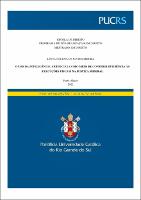| Share record |


|
Please use this identifier to cite or link to this item:
https://tede2.pucrs.br/tede2/handle/tede/10679Full metadata record
| DC Field | Value | Language |
|---|---|---|
| dc.creator | Moura, Lúcia Helena de Matos | - |
| dc.creator.Lattes | http://lattes.cnpq.br/2499039090078907 | por |
| dc.contributor.advisor1 | Silveira, Paulo Antonio Caliendo Velloso da | - |
| dc.contributor.advisor1Lattes | http://lattes.cnpq.br/9047483160060734 | por |
| dc.contributor.advisor-co1 | Jobim, Marco Félix | - |
| dc.contributor.advisor-co1Lattes | http://lattes.cnpq.br/7781138223264118 | por |
| dc.date.accessioned | 2023-03-28T14:53:38Z | - |
| dc.date.issued | 2022-11-24 | - |
| dc.identifier.uri | https://tede2.pucrs.br/tede2/handle/tede/10679 | - |
| dc.description.resumo | A recuperação dos créditos tributários e não tributários de interesse da União é realizada por meio de ação de execução fiscal perante a Justiça Federal, Justiça do Trabalho e Justiça Eleitoral. O Conselho Nacional de Justiça publica anualmente o Relatório Justiça em Números onde é mostrado, reiteradamente, o alto índice de congestionamento de execuções pendentes no Poder Judiciário, dentre estas as execuções fiscais, consideradas o gargalo. A principal causa deste cenário é a dificuldade enfrentada pelas varas de execuções fiscais em localizar o executado e o respectivo patrimônio a ser penhorável para a quitação dos débitos. Diante deste panorama, alguns tribunais de justiça resolveram aplicar alternativas de resolução, e o caminho encontrado foi o desenvolvimento de sistemas de Inteligência Artificial para o desempenho de tarefas preditivas. Diante dos resultados satisfatórios, o Conselho Nacional de Justiça disciplinou esta inovação por meio da Resolução nº 395, de 07 de junho de 2021. A partir daí, o Processo Judicial Eletrônico (PJE) foi substituindo os autos em meio físico e novos sistemas de Inteligência Artificial foram desenvolvidos por tribunais da Justiça Estadual. Como exemplo, temos o Sistema Sinapses do Tribunal de Justiça do Estado de Rondônia, o qual alberga outros sistemas de Inteligência Artificial utilizados em execuções fiscais. A mesma experiência deve ser utilizada pela Justiça Federal. Tratam-se de plataformas algoritmicas programadas para realizar tarefas repetitivas cujos resultados são alcançados em segundos, se comparados a meses. O uso de sistemas de Inteligência Artificial em uso nas plataformas algoritmicas são desenvolvidos pelo método de Aprendizado de Máquina – ou Machine Learning –, de forma supervisionada, a fim de que seja alcançada a satisfação dos créditos públicos que, a cada ano, chegam ao patamar de bilhões que deveriam chegar aos cofres públicos. Didaticamente, é mostrado o funcionamento destes sistemas sob a forma de notas introdutórias da Inteligência Artificial cujo caminho se inicia com a respectiva origem até a aplicação nos processos judiciais. A questão da eficiência, que é o grande objetivo a ser alcançado na Justiça Federal, é destacada como norma-princípio e, portanto, necessária para o devido processo legal. O uso da Inteligência Artificial na Justiça Federal nos atos preditivos encurta o tempo de giro das execuções fiscais e, assim, evita a decretação da prescrição intercorrente. Caso ocorra um possível erro nos algoritmos, programa-se novamente excluindo a sua causa. Conclui-se que é possível a redução do alto índice de congestionamento de execuções fiscais na Justiça Federal a partir do uso de plataformas algoritmicas programadas para localizar o devedor e os seus bens, com observância ao princípio da dignidade da pessoa humana. | por |
| dc.description.abstract | The recovery of tax and non-tax credits of interest to the Union is carried out through tax enforcement action before the Federal Courts, Labor Courts and Electoral Courts. The National Council of Justice annually publishes the Justice in Numbers Report, which shows, repeatedly, the high rate of congestion of pending executions in the Judiciary, among these tax executions, considered the bottleneck. The main cause of this scenario is the difficulty faced by the tax enforcement courts in locating the debtor and the respective assets to be attached to settle the debts. Given this scenario, some courts of law decided to apply alternative solutions, and the path found was the development of Artificial Intelligence systems for the performance of predictive tasks. In view of the satisfactory results, the National Council of Justice disciplined this innovation through Resolution No. 395, of June 7, 2021. From there, the Electronic Judicial Process (PJE) was replacing the records in physical media and new intelligence systems Artificial were developed by State Courts of Justice. As an example, we have the Synapses System of the Court of Justice of Rondônia, which houses other Artificial Intelligence systems used in tax executions. The same experience must be used by the Federal Court. These are algorithmic platforms programmed to perform repetitive tasks whose results are achieved in seconds, compared to months. The use of Artificial Intelligence systems in use on algorithmic platforms are developed by the Machine Learning method - or Machine Learning -, in a supervised way, in order to achieve the satisfaction of public credits that, every year, reach the level billions that should reach the public coffers. Didactically, the functioning of these systems is shown in the form of introductory notes on Artificial Intelligence whose path starts with the respective origin until its application in judicial proceedings. The issue of efficiency, which is the main objective to be achieved in the Federal Court, is highlighted as a principle-norm and, therefore, necessary for due process of law. The use of Artificial Intelligence in Federal Justice in predictive acts shortens the turnaround time of tax executions and, thus, avoids the decree of intercurrent prescription. If a possible error occurs in the algorithms, it is programmed again, excluding its cause. It is concluded that it is possible to reduce the high rate of congestion of tax executions in the Federal Court from the use of algorithmic platforms programmed to locate the debtor and his assets, in compliance with the principle of human dignity. | eng |
| dc.description.provenance | Submitted by PPG Direito ([email protected]) on 2023-03-23T16:44:44Z No. of bitstreams: 1 LÚCIA_HELENA_DE_MATOS_MOURA_DIS.pdf: 1294996 bytes, checksum: d72f6b943de3e4b2b9fc3d1fc290ae7e (MD5) | eng |
| dc.description.provenance | Approved for entry into archive by Sarajane Pan ([email protected]) on 2023-03-28T14:48:16Z (GMT) No. of bitstreams: 1 LÚCIA_HELENA_DE_MATOS_MOURA_DIS.pdf: 1294996 bytes, checksum: d72f6b943de3e4b2b9fc3d1fc290ae7e (MD5) | eng |
| dc.description.provenance | Made available in DSpace on 2023-03-28T14:53:38Z (GMT). No. of bitstreams: 1 LÚCIA_HELENA_DE_MATOS_MOURA_DIS.pdf: 1294996 bytes, checksum: d72f6b943de3e4b2b9fc3d1fc290ae7e (MD5) Previous issue date: 2022-11-24 | eng |
| dc.format | application/pdf | * |
| dc.thumbnail.url | https://tede2.pucrs.br/tede2/retrieve/186862/L%c3%9aCIA_HELENA_DE_MATOS_MOURA_DIS.pdf.jpg | * |
| dc.language | por | por |
| dc.publisher | Pontifícia Universidade Católica do Rio Grande do Sul | por |
| dc.publisher.department | Escola de Direito | por |
| dc.publisher.country | Brasil | por |
| dc.publisher.initials | PUCRS | por |
| dc.publisher.program | Programa de Pós-Graduação em Direito | por |
| dc.rights | Acesso Aberto | por |
| dc.subject | Inteligência Artificial | por |
| dc.subject | Execução Fiscal | por |
| dc.subject | Eficiência | por |
| dc.subject | Justiça Federal | por |
| dc.subject | Artificial intelligence | eng |
| dc.subject | Tax Enforcement | eng |
| dc.subject | Efficiency | eng |
| dc.subject | Federal Justice | eng |
| dc.subject.cnpq | CIENCIAS SOCIAIS APLICADAS::DIREITO | por |
| dc.title | O uso da inteligência artificial como meio de conferir eficiência às execuções fiscais na justiça federal | por |
| dc.type | Dissertação | por |
| dc.restricao.situacao | Trabalho não apresenta restrição para publicação | por |
| Appears in Collections: | Programa de Pós-Graduação em Direito | |
Files in This Item:
| File | Description | Size | Format | |
|---|---|---|---|---|
| LÚCIA_HELENA_DE_MATOS_MOURA_DIS.pdf | LÚCIA_HELENA_DE_MATOS_MOURA_DIS | 1.26 MB | Adobe PDF |  Download/Open Preview |
Items in DSpace are protected by copyright, with all rights reserved, unless otherwise indicated.




